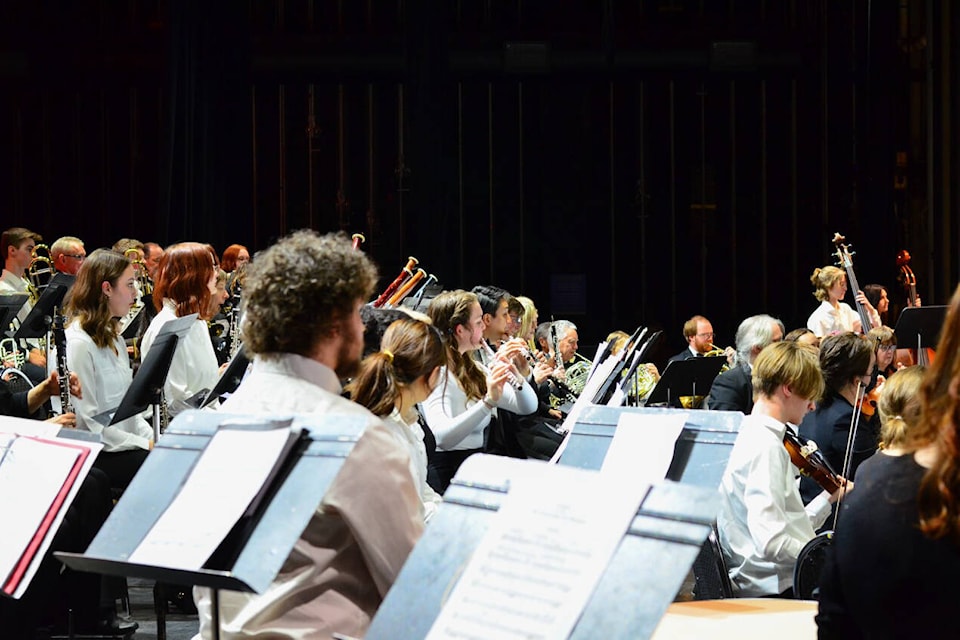Karen Krout
Special to The Morning Star
Patrons of the Okanagan Symphony Orchestra were given the gift of music full of light on March 3, perfect for a gloomy early spring evening. Maestra Rosemary Thomson is gifted at programming music which creates a mood for the evening, while providing variety. Sergei Prokofiev (1921 - 1953) set out to write a symphony in the classical style using the classical form in the style of Mozart but he used modern orchestration and instrumental techniques. The four movements included an opening allegro con brio with a playful, childlike character in which the woodwinds had lovely solos, beautifully executed. The second movement is a sweet and tender larghetto with the opening melody played by the first violins, led by acting concertmaster Susan Schaffer, blending beautifully in their highest range. Acting principal second violin Narumi Higuchi did a great job leading the second violins and coordinating with the first violins. The third movement is a graceful gavotte and the Finale: Molto Vivace brings to mind the frenetic scurrying and noisiness of our modern world.
The Violin Concerto in E minor, Opus 64 by Felix Mendelssohn, is an early romantic concerto which has much of the lightness of the classical period. The violin soloist Adrian Anantawan, a gifted virtuoso, born without a right hand, produced a beautiful sound using a sophisticated prosthetic for his bow arm. The first movement, Allegro ma non tanto, was played with sensitivity and expressiveness, but in the middle range of the violin the balance between orchestra and soloist was poor, mostly because the stage at the �������� Community Theatre is quite dead and the musicians seemed to have difficulty hearing the soloist when he changed tempo (which is one reason we need a new performing arts centre with an orchestra hall as soon as possible). The second movement Adagio was a love song, beautifully performed with expressive touches by Anantawan. The Finale: Alla breve, was a fast and virtuosic dance played by the woodwinds and solo violin in harmony, difficult to coordinate in this hall. Double stops with trills and running octaves and very high leaps were played with perfect ease by this virtuoso. Adrian Anantawan has a very big heart and a dedication to teaching and encouraging young players, including those with similar challenges—an advocate for disability and the arts. He stated on the video The Story Behind the Music that his goal is to be kind. The full-house audience gave a standing ovation after this performance.
After intermission the orchestra went to France with Augusta Holmès’ Ludus Patria: Interlude—La Nuit et l’Amour. Holmès was unfortunately born in an age (1847 - 1903) when women were not encouraged to be composers of music. She was denied entry to the Paris Conservatory, so she took lessons on her own. During her lifetime she achieved success with her well-crafted compositions but was forgotten after her death due to the chauvinistic attitudes of the age. Fortunately there is currently a revival of her music, along with that of other women composers. The second movement of the work was written as an orchestral interlude and evokes romantic emotions, especially in the soaring opening melody in the violas and celli, who created a full rich sound.
Wolfgang Amadeus Mozart’s Symphony No. 31, KV.297 (Paris) was composed in Paris in 1778 where Mozart received several commissions from Impresario Jean Le Gros, including this symphony. He composed it with colour and excitement to please French audiences and they were thrilled with it. He thought that they would love the theme in the middle of the first movement, Allegro ma non tanto, and he was right. This symphony has three movements rather than the customary four, and it’s the first symphony in which Mozart included the clarinet. The second movement is a graceful Intermezzo and the final movement is a rousing allegro which the French audience loved.
Karen Krout is a retired musician and violin teacher who is grateful to be living, hiking and playing music with friends in the unceded traditional territory of the Syilx/Okanagan people.
READ MORE:
READ MORE:
newsroom@vernonmorningstar.com
Like us on and follow us on .




